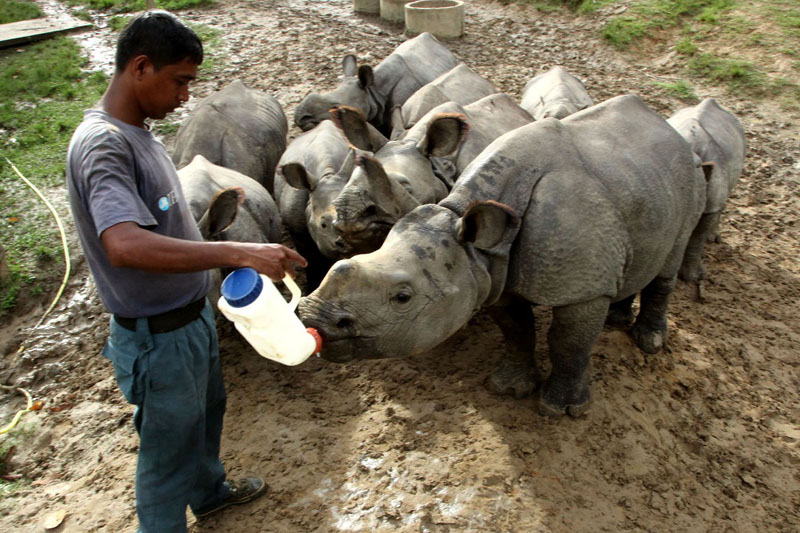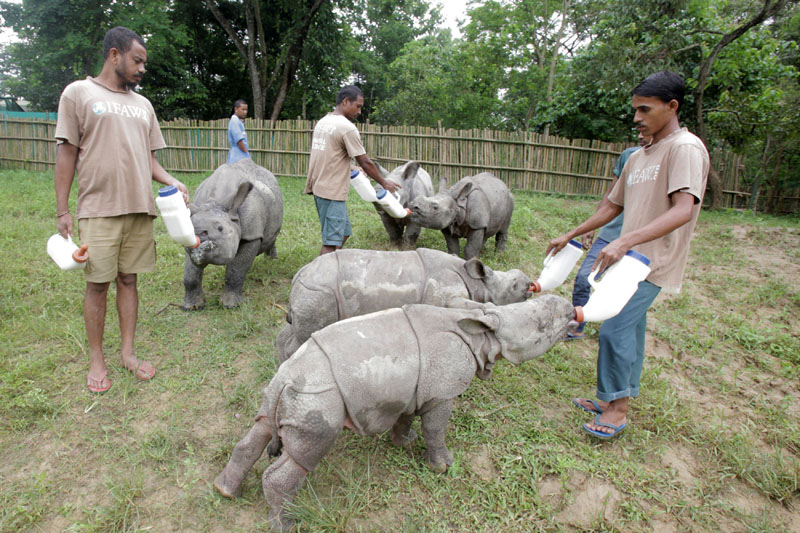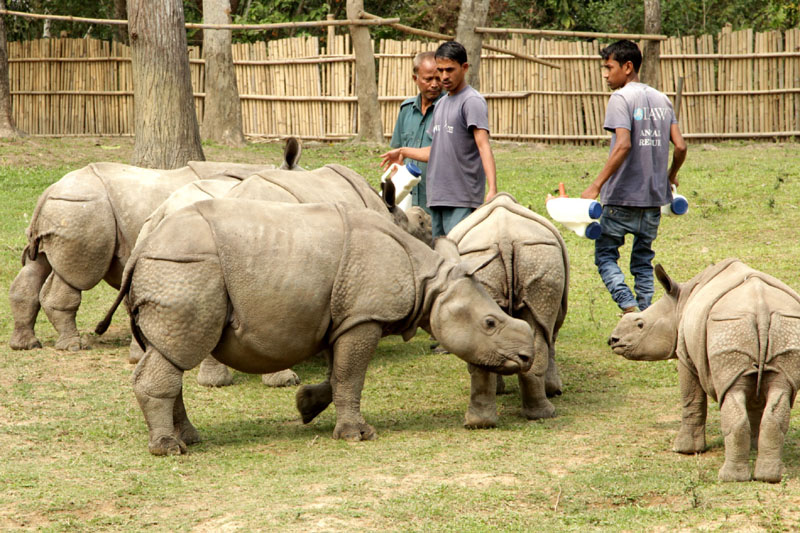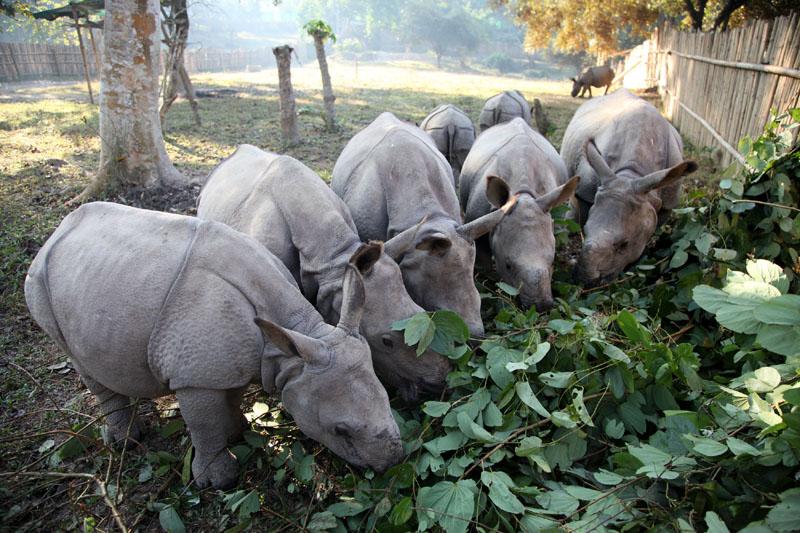Growing Wild: the rescued rhino calves
It’s been a year since Kaziranga National Park was inundated by the worst floods to have hit Assam in over a decade. Among the 100-plus wild animal emergencies that CWRC (the Centre for Wildlife Rehabilitation and Conservation: the wildlife rescue, treatment and rehabilitation centre run by Wildlife Trust of India (WTI), the International Fund for Animal Welfare (IFAW) and the Assam Forest Department near Kaziranga) and its Mobile Veterinary Service units attended during the floods last year, were eight orphaned rhino calves that were rescued and brought to the centre to be hand-raised.
The simultaneous long-term care of eight rhinos has been a massive challenge for the team at CWRC. In addition to the efforts of the centre’s animal keepers and veterinarians, the tremendous support received from individual and corporate supporters, the Government of Assam, the Kaziranga National Park Authority and people from all walks of life across Assam has been critical.
“I remember that a group of children from a remote school had given up a mid-day meal to buy milk formula for the rhino calves”, says Dr Rathin Barman, WTI Joint Director and centre-in-charge, CWRC. “There have been several such touching expressions of support. We extend our heartfelt gratitude to the people of Assam and all well-wishers for their support and encouragement over the past year.”
When the rhino calves were first brought to CWRC they were stabilised at the centre’s Large Animal Nursery. Once they had recovered from their flood-related trauma and injuries they were shifted to a small outdoor paddock attached to the nursery. Gradually, having acclimatised to the outdoors, they were introduced to three larger paddocks with a natural stream running through them. This allowed the calves to wallow and play – an important part of their natural developmental behaviour.
“The calves have grown fast”, says Dr Panjit Basumatary, the lead veterinarian at CWRC. “Importantly, they’ve experienced all four seasons now, in an approximation of their natural habitat. It was touching to see how the younger calves huddled close to the older ones at night to keep warm during the winter, as they would have with their mothers. Now, as they play in the mud, enjoy the rain or nap together as they would in their natural environment, we feel a sense of satisfaction that they are making good progress towards a life in the wild.”
CWRC currently has ten rhino calves under care. The eight calves rescued last year had already bonded with an older calf that was rescued in 2015. Another under care four- to six-month-old calf displaced by the monsoon floods was rescued from Burhapahar and brought to the centre earlier this month during Kaziranga flood 2017.
Random Stories
8 Aug 2016 - 4:44pm |
AT News
Parliament on Monday condoled the death of 14 people in the recent Kokrajhar carnage as it resumed the session on Monday morning. Speaker Sumitra Mahajan read out the statement and called it an act...
12 Sep 2016 - 6:28pm |
Syed Miraz Ahmed
After having garnered much appreciation for its sartorial splendor in India’s best fashion based reality show, ‘India’s Next Top Model 2’ culminated on a high note with Patna girl, Pranati Rai...
26 Jun 2017 - 11:49pm |
Rajib Das
The International Day against Drug Abuse and Illicit Trafficking was organized by the Indian Red Cross Society, Baksa District Branch at Barama on June 26 in a day long programme. Tupal Ramchiary...
14 Jul 2015 - 9:54pm |
AT News
A businessman and his daughter died and two others sustained injury when suspected ULFA men sprang upon a family in Tinsukia district on Tuesday.The incident took place at around 7.30 in the evening...
Other Contents by Author
Marking a significant milestone for conservation of Amur falcons in the northeast Indian state of Nagaland, three villages in Wokha district have pledged to save the migratory raptor in Doyang Reservoir - its largest roosting site in the country. With mass annual hunt potentially threatening the species, a resolution has been cleared by the villages to penalise offenders, this year onwards.Village Council Members (VCM) of Pangti, Asshaa and Sungro signed a tri-party Memorandum of Understanding with the Wildlife Trust of India (WTI) and the Wokha-based NGO Natural Nagas, to assist the Nagaland Forest Department to stop the wide-scale hunt which was brought to light last year.Tens of...
A sub-adult wild tusker stranded in human-dominated area in Nagaon district of Assam was successfully translocated to the wild. The exhaustive two-day rescue operation was carried out by the Forest Department assisted by IFAW-WTI team, local elephant experts, mahouts and phandies, with local police and paramilitary forces fencing the crowd of thousands.The tusker was separated from its herd, was disoriented and had been taking shelter for over 70 days in and around Kaki Reserve Forest. It had been caught in conflict with people, resulting in damage to property and crops and even casualty of a farmer; it was also treated for gunshot injuries by the authorities assisted by...
A seven-year old male leopard is being shifted today to the Nagaland Zoological Park from the Centre of Wildlife Rehabilitation and Conservation (CWRC), near Kaziranga National Park. The Assam Forest Department and International Fund for Animal Welfare -Wildlife Trust of India (IFAW-WTI) run CWRC had been taking care of the leopard since 2006, after he was found alone in a tea garden by locals and handed over to the authorities. "When we get any animal at CWRC, our first choice is to look into rehabilitation back in the wild. However, rehabilitation is not an easy option for large carnivores, considering the need for extensive space as they are territorial animals, and...
The International Fund for Animal Welfare - Wildlife Trust of India (IFAW-WTI) has provided 35 boats to the Kaziranga National Park authorities to assist in anti-poaching patrolling in the flood-prone UNESCO World Heritage that houses more than 70% of the world's greater one horned rhinoceros.The boats are largely aimed at providing assistance to the local field staff in their patrolling (anti poaching) activities during the floods in Kaziranga National Park. Every year the park faces flooding of the Brahmaputra river, causing many animals to wander out in search of higher grounds. Many that are caught in the floods are rescued and rehabilitated by the Forest...
As preparations to tackle potential flood emergencies are on at the Centre for Wildlife Rehabilitation and Conservation (CWRC), good news poured in for the rehabilitators, as yet another rhino hand-reared here gave birth to a healthy calf in the wild in Manas National Park.The female rhino, named Jamuna, was rescued as a three-month-old calf during the annual floods in the famed Kaziranga National Park in June 2004, by the Assam Forest Department. She was admitted to the Assam Forest Department and IFAW-WTI run CWRC near Kaziranga for hand-raising and rehabilitation. In 2007, she along with another female calf, Ganga, was moved to Manas NP.With this, all three female rhinos...
A rescued rhino calf, Purabi, under care at Centre for Wildlife Rehabilitation and Conservation (CWRC) was moved to Manas National Park today, to join an orphaned rhino calf being hand-reared there. This is being done to increase the rehabilitation prospects of the latter calf which has been deprived of company of its kind since its mother was poached early this year.“We have been rescuing rhino calves at Kaziranga in various circumstances and most of them are now successfully hand raised at CWRC. At due course of time all these calves go back to the wilderness again,” said NK Vasu, Chief Conservator of Forest and Director, Kaziranga National Park.Purabi was separated from her mother...









Add new comment